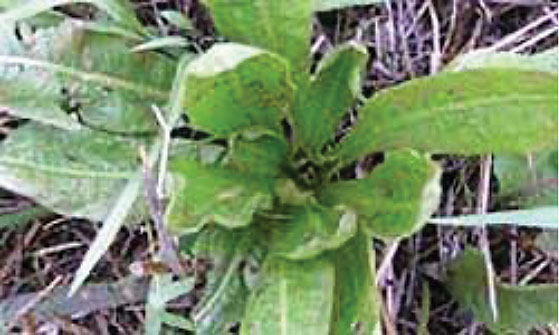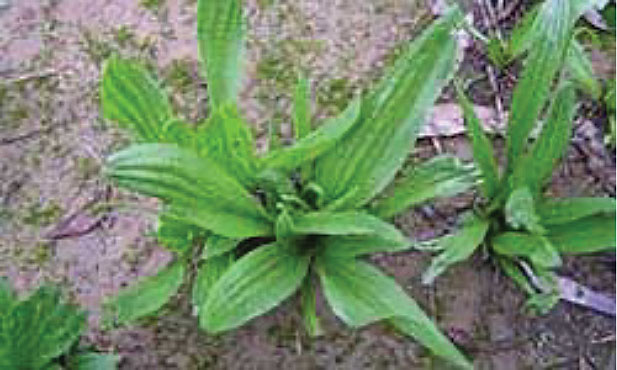Specialist forages for opportunistic summer feed
There are a number of fodder options that can provide some quick feed over summer – if summer rains fall. This article has been updated from a lamb finishing article in 2022 to include further comments and options for this situation.
Options for summer crops will depend on the region, soil moisture and summer rainfall. They include maize, millet, sorghum, chicory, brassicas and legumes. These can also be useful in a pasture renovation program and/or for providing quality feed for growing out or finishing stock.
Soil temperature
The soil temperature requirements for summer crops such as brassicas/forage rape, maize, millet or sorghum are in Table 1. (Source: Article by Laura Forward in autumn 2022 SheepNotes)
When measuring soil temperature in preparation for sowing, there are two very easy methods
1. Use a temperature probe/soil or meat thermometer – put this into the ground to about 10cm deep, in an area that is representative of your paddock (not under a tree, etc.) at around 10am for three consecutive days. The average of those three measurements is the temperature that you will use to make a decision.
2. If you have a soil moisture probe, or one near you on the network, this will give you a live reading of the current soil temperature. Soil moisture probes and real time information is available at: extensionaus.com.au/soilmoisturemonitoring/
Millet and sorghum
(Source Dairy Australia)
Millet and sorghum are summer forage options due to their potential to rapidly accumulate dry matter in warm conditions. They perform better than most other annual summer crops when soil moisture is limited, making them a good option when water is scarce. Millet and sorghum have a high tolerance to water stress and low risk of insect attack and as a result produce more feed than most broad leaf summer crop options. However, yields can be affected by low temperatures in summer.
The nutritional value of millet and sorghum tends to be less than other summer crops. Both are lower in crude protein (6–9%) than other summer crop options and higher in fibre concentration which will affect dry matter intake. If managed properly they can have moderate metabolisable energy (ME) but they rapidly lose quality once they get past the ideal grazing height. Brassicas or herbs such as chicory or plantain are a better alternative in this regard.
Toxicity risks: Sorghum especially has the risk of prussic acid poisoning of stock if grazed at certain stages of growth.
Table 1: Top-soil temperature requirements for spring-sown species
Brassica | Maize | Millet | Sorghum | |
|---|---|---|---|---|
Below 8 | Will begin to strike, but slow and not ideal | x | x | x |
Between 8 and 12 | ✓ | Will strike, but will be slow | x | x |
Between 12 and 15 | ✓ | ✓ | x | x |
Forage brassicas and summer canola
Forage brassicas (particularly forage rape species) are a popular option for providing quality feed in summer/autumn. They are suited to a range of soil types of varying fertility and have the capacity to produce a good quantity of feed with high nutritive value over an extended period, when winter active grass-based pastures are generally declining in quantity and quality. They can support good growth rates for lambs, however, it can take 2-3 weeks for animals to adapt before feed consumption and growth rates increase. Some results for lamb performance with other forages are provided below.

Spring sown canola
Spring sowing of winter-type canola varieties can be used as replacement for the spring sowing of a brassica/forage rape crop for sheep production and produce similar levels of dry matter to traditional brassica forages. It can produce three to four t DM/ha of feed with high nutritive value (~12 MJ /kg DM and 14% CP) over summer and autumn and into winter. If adequate growth occurs the crop can be grazed a number of times until the following winter, when it can then be locked up for seed/oil production. This system should be considered in regions with longer growing seasons suitable for spring sowing and where there is a reasonable incidence of summer rainfall events. Studies at Agriculture Victoria Hamilton SmartFarm have shown lamb growth rates ranged from 100 to 240 g/day once the lambs adapted to canola.
All winter-type canola varieties can be used for spring sowing where they have a vernalisation requirement and a longer flowering date. Spring-type canola varieties are not suitable for spring sowing, as they will try to flower early and reach maturity too soon.
Forage comparisons
A field experiment at Hamilton SmartFarm, in 2014 and 2016 tested seven forage treatments – canola (two different cultivars), forage brassica, lucerne, chicory, plantain and perennial ryegrass. Herbage mass and nutritive characteristics of the canola varieties were similar to forage brassica. Herbage mass in March 2014 was 3.35–3.64 t DM/ha for brassicas; 1.05–1.37 t DM/ha for perennial ryegrass, plantain and chicory; and 2.94 t DM/ha for lucerne. In March 2016, herbage mass was 1.86–2.05 t DM/ha for brassicas and 2.14–2.49 for the other forage treatments. Brassicas had higher ME concentrations and lower neutral detergent fibre (NDF) concentrations on most sampling dates compared to chicory, plantain, lucerne and perennial ryegrass. The crude protein concentration of the brassica treatments was not different from that of the other forage treatments.
Ewe lamb growth rates and conception rates were assessed for an autumn mating in 2014 and 2016. The grazing canola and brassica produced similar live weight gains (in the mating and pre-mating period) of 140 g/head/day compared to 60 g/hd/day on perennial ryegrass. Note that sheep grazing perennial ryegrass were fed additional supplement in order achieve positive growth rates. Table 2 shows the reproduction rates (as foetuses scanned) for the forages, with the highest rates for the lucerne, canola and chicory respectively. In the 2016 experiment, there were no difference in reproductive rate between the forage options grazed.
Chicory
There are two types of chicory – perennial which are bred to last 3 years plus and biannual which last 12-18 months. Chicory requires a minimum annual rainfall of 500-600 mm and will tolerate a lower soil pH. It has high nutritive value and mineral levels, with a crude protein level of 14 – 24 % and an energy value of 10.3 – 12.1 MJME/kg DM in the leaves. But care should be taken when grazing as a crop, as it can have quite low fibre levels. Hay or access to a grass paddock, or on off grazing may need to be provided to minimise the risk of acidosis. As a summer fodder crop, chicory should be sown when soil temperatures are at least 12 degrees and rising. Chicory can be sown in a mix, although this reduces chemical weed control options as broadleaf herbicides cannot be used. Red legged earth mite attack can be an issue during germination. While an after sowing insecticide can be used, it is recommended to use a treated seed which contains an insecticide to protect emerging seedlings.
Table 2. Reproduction rate (as foetuses scanned) on different forages with an autumn mating in 2014 (Hamilton)
Canola | Forage brassica | Lucerne | Chicory | Plantain | Perennial ryegrass | |
Reproduction rate (%) | 145 | 130 | 150 | 140 | 130 | 100 |

Chicory is a warm season growing plant, so is most productive during late spring, summer and into early autumn. With high levels of tannins, chicory does not cause bloat in stock. It can be oversown with grasses or cereals in the autumn if needed to provide winter feed. Look to graze chicory at the 7-8 leaf stage. Soil moisture data from the EverGraze project indicates it dries the soil to three metres, which is comparable to lucerne and it responds well to summer rain events.
Performance of lambs grazing chicory can have growth rates of 190-370 g/day compared with ryegrass at 160-230 g/day or lucerne at 170-300 g/day (Chicory factsheet, NSW DPI 2011). This may be important in areas where summer rainfall is unreliable and faster turn-off of lambs is required. In a lamb finishing experiment in New South Wales, lambs were finished on either lucerne based pasture or on chicory swards. Lambs grazing chicory grew faster than lambs grazing lucerne in three out of five groups with average growth rates of between 172-312 g/day (Holst et al 1998). In the Central Tablelands region of NSW, chicory produced lamb growth rates of 125 g/day during finishing, allowing greater opportunities for producers in an environment where summer rainfall is unreliable (Holst et al 2006).
Plantain (Plantago lanceolata)
Plantain is a perennial herb requiring 550 – 650 mm annual rainfall. It is adapted to a wide pH range (pH CaCl2 4.2 – 7.8) and can tolerate low fertility soils and drought. Plantain typically has a nutritive value of 16% crude protein in the vegetative stage, and an energy level of 10-12 MJME/kg DM with dry matter digestibility of 72% (leaf) and 59% (stems), and fibre levels of 35-50% NDF. It can have lower palatability compared with other forage species, particularly in the seed head stage, or when the plants have low nitrogen status, or the grazing rotations become too long. Plantains growing season is fairly similar to perennial ryegrass, but does provide additional growth into the shoulders of summer and autumn.

Newer varieties of plantain also show improved winter production, providing valuable feed during that period. It has a relatively high concentration of magnesium (Mg) and calcium (Ca) which may assist in reducing the risk of grass tetany in mixed pastures. Plantain can be included in pasture mixes containing grasses and legumes but needs careful management to ensure it isn’t smothered by other species.
Lamb performance on pure plantain has generally been poorer than on chicory and brassicas but better than perennial ryegrass and much better than barley and silver grass in the summer/ early autumn.
Sowing chicory and plantain in spring for an opportunistic grazing if and when rain falls and then over sowing in autumn with a cereal may be an option worth considering.
Further information
Visit Feedinglivestock.vic.gov.au to view a webinar on summer forage crop opportunities for lambs or a factsheet on canola Dairy Australia website – summer crops.
Further information contact: Neil James, Agriculture Victoria, 0417 353 929.